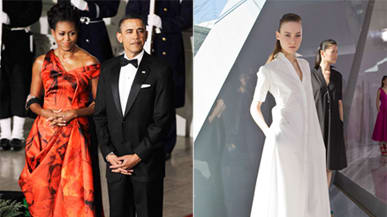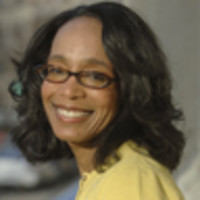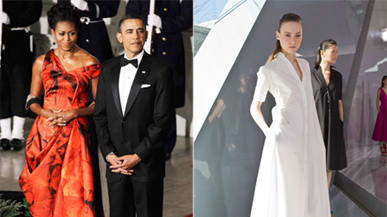After more than a week of catwalk shows and showroom presentations, the New York fashion industry finished up its Fall 2011 runway season Thursday afternoon with all the frisson of a shrug. For an industry that has spent the greater part of a month lambasting First Lady Michelle Obama for not wearing an American designer’s dress to the state dinner for China, the home team did not provide much in the way of creative exuberance to prevent such public injury from happening again.

Indeed, the most provocative collection was not for fall at all, but instead was a modest group of 16 summer dresses that Derek Lam created in conjunction with eBay. The public can vote online for its favorite dresses and the top five selections will be produced by the designer and put up for sale on the auction website in time to be enjoyed this spring. At last, here is a designer giving customers precisely what they want, exactly when they want it—at a reasonable price, too.
Lam’s eBay dresses are not elaborately designed or stitched from the most luxurious fabrics. They can’t be when they’re priced from $125 to $295. But at least he’s making an effort to listen to the customer and get the merchandise out in real time rather than pretending that this is still a culture willing to wait six months for a frock when it could barely wait a year for the overhaul of the health-care system.
While Lam is servicing customers, everyone else is still fussing about muses, agonizing over seating charts and risking their entire business on a guessing game that tries to determine consumer desires without ever talking to actual consumers.
The quality of what designers have conjured from their own imagination has been the subject of many conversations among editors this week who are all busy asking each other a single question: What did you think? The reason for that query is not merely curiosity or polite conversation, but also exasperation. Editors are hopeful that a colleague might enlighten them on some presentation that was overlooked or a collection that was woefully misunderstood. Was there a moment of creative brilliance that has gone undetected?
No, not really. A few names keep rising to the surface as having produced fall lines that were especially lovely or simply the kind of well-considered clothing that women—and men, for that matter—want to wear. Names in regular rotation include The Row, Rodarte, Marc Jacobs, Billy Reid, and Michael Kors. Mostly, though, fall promises to be a rather bland season—at least as envisioned by American designers.
After all the righteous indignation over Michelle Obama’s recent wardrobe choice, the industry needed to serve up irresistible fall collections. But that didn’t happen.
Fashion has its highs and lows, but the fact that the collections shown in Lincoln Center, and in a series of galleries and warehouses in Chelsea, are notably blah comes at a particularly inopportune moment. After all the righteous indignation and hoary lamentations over Mrs. Obama’s recent wardrobe choice, the industry needed to serve up fall collections so irresistible that turning elsewhere—to London or Paris—would be unthinkable to the fashion-savvy first lady…and the rest of the country’s style-loving shoppers. But that didn’t happen.
In many ways, the dilemma for Seventh Avenue is reminiscent of one faced by the American auto industry back in the 1980s, when Detroit suggested that it was practically unpatriotic to buy foreign cars—all the while churning out boxy, bland, and often unreliable vehicles. The fashion industry hasn’t exactly rolled out a season’s worth of Chrysler K-cars, but there has been little in the way of surprises and only a few modest enticements.
Vera Wang, for instance, showed a collection based on flouncy little dresses full of pleats and tucks and paired them with voluminous parkas. (Having survived a rolling onslaught of East Coast snowstorms, designers seem virtually obsessed with parkas puffy enough to see them through a trip to Antarctica.) The problem, however, was that Wang had only one idea on her runway. After countless permutations of a whisper-thin dress and an explorer’s parka in varying shades of taupe and gray, one longed for a pair of trousers or, perhaps, something in tweed. Kors celebrated his 30th anniversary with a collection that put a contemporary spin on the loose-limbed, luxe sensibility that was popular when he was just starting out. It was a collection of ponchos, caftans, jumpsuits, pajama pants, and capes all done up in cashmere luxurious enough to break a fall. But it was a celebration of past achievements, not a leap toward the future. And while Marc Jacobs managed to make rubber trousers look sophisticated and his polka dot separates had charm, a dotted pullover does not move the fashion needle forward.
The Row offered grown-up luxury with mustard-colored trousers, lightweight frame handbags, and indulgent fox jackets. At Calvin Klein, Francisco Costa showed restrained shifts in subtly shifting textures from ivory to mocha. Narciso Rodriguez gave his audience dresses in blocks of color and in abstract prints. Proenza Schouler made a bid to revive the art of macramé and for that alone they should be cheered, if only because it is deliciously kitsch. And Rodarte’s eccentrically conceived floor-length dresses were feminine and elegant. (The hand-knit sweaters and high-waisted trousers, however, blurred into a mish-mash of autumnal shades and the pony-skin collage bodices and overskirts had the unsettling look of Laura Ingalls couture.) It was attractive but not compelling and one almost wished designers Kate and Laura Mulleavy would go back to obsessing over Japanese horror films because back then at least their “blood”-splattered garments could roust an audience from its malaise.
The menswear designer Thom Browne presented his womenswear collection at the New York Public Library in the form of a nun’s defrocking. And yes, indeed, that made the audience go wide-eyed with curiosity. The models, dressed in traditional habits, approached a makeshift altar where two square-jawed faux priests helped them disrobe. Hiding underneath the robes were skinny plaid trousers and contrasting blazers, ankle-length skirts, sculpted skirts and coats that encased the torso like a shell. It was all intriguing and wholly connected to the designer’s menswear, but it left one wondering who might be the customer for clothes that are both austere and audacious. The frocks aren’t classically pretty, feminine, or sexy. They are not grounded in clean tailoring. They are too fussy to be deemed minimal. Who is this customer? If you’re out there, please show yourself!
Browne designs in a manner that adheres to his personal aesthetic but that pays scant attention to the ways in which most women think about their clothes and their public selves. Every designer has to listen to the inner voice that drives them, but they can’t allow that voice to drown out all others.
And long before designers declare that a certain kind of woman—or one White House-dwelling woman in particular—should wear their clothes, they need to find out what she wants and then ask themselves whether they are able and willing to provide it.
Robin Givhan is a special correspondent for style and culture for Newsweek and The Daily Beast. In 1995 she became the fashion editor of The Washington Post, where she covered the news, trends and business of the international fashion industry and wrote a weekly style column. She has contributed to several books including Runway Madness, No Sweat: Fashion, Free Trade and the Rights of Garment Workers , and Thirty Ways of Looking at Hillary: Reflections by Women Writers . She is the author, along with The Washington Post photo staff, of Michelle: Her First Year as First Lady . In 2006, she won the Pulitzer Prize in criticism for her fashion coverage. She lives and works in Washington, DC.

